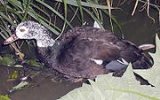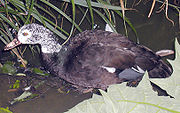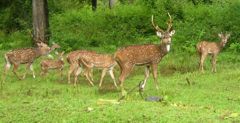
Biodiversity of Assam
Encyclopedia
The Biodiversity of Assam, a state
in North-East India
, makes it a biological hotspot with many rare and endemic plant and animal species. The greatest success in recent years has been the conservation of the Indian rhinoceros
at the Kaziranga National Park
, but a rapid increase in human population in Assam threatens many plants and animals and their natural habitats.


 Apart from the Rhinoceros and the Tiger, the Spotted Deer or Chital
Apart from the Rhinoceros and the Tiger, the Spotted Deer or Chital
/ Futukihorina (Axix axix), the Swamp Deer or Dolhorina (Cervus duvauceli duvauceli), the Clouded Leopard
(Neofelis nebulosa), the Hoolock Gibbon
, Pigmy Hog or Nol-gahori (Sus salvanis), the Hispid Hare
, the Golden Langur (Trachypithecus geei), the Golden Cat
, the peculiar Giant Civet
, the Binturong
, the Hog Badger
s, the Porcupine
s, the Civet cat
s, etc. are found in Assam. Moreover, there are abundant numbers of Gangetic Dolphin
s, Mongoose
s, Giant Squirrels and Pythons. The largest population of the Wild Water Buffalo anywhere is in Assam
Few of the major birds in Assam are: Blue-throated Barbet
or Hetuluka (Megalaima asiatica), the White-winged Wood Duck
or Deuhnah (Cairina scultulata), the Ring-tailed Fishing Eagle or Kuruwa (Haliaeetus leucorythus), the Great Pied Hornbill or Rajdhonesh (Buceros bicornis homrai), the Himalayan Golden-backed Three-toed Wood-pecker or Barhoituka (Dinopium shorii shorii), and the Migratory Pelicans.
.jpg) Assam is also known for orchids
Assam is also known for orchids
and also for valuable plant species and forest products.
(Also see: Physical Geography of Assam
)
Assam
Assam , also, rarely, Assam Valley and formerly the Assam Province , is a northeastern state of India and is one of the most culturally and geographically distinct regions of the country...
in North-East India
North-East India
Northeast India refers to the easternmost region of India consisting of the contiguous Seven Sister States, Sikkim, and parts of North Bengal...
, makes it a biological hotspot with many rare and endemic plant and animal species. The greatest success in recent years has been the conservation of the Indian rhinoceros
Indian Rhinoceros
The Indian Rhinoceros is also called Greater One-horned Rhinoceros and Asian One-horned Rhinoceros and belongs to the Rhinocerotidae family...
at the Kaziranga National Park
Kaziranga National Park
Kaziranga National Park is a national park in the Golaghat and Nagaon districts of the state of Assam, India. A World Heritage Site, the park hosts two-thirds of the world's Great One-horned Rhinoceroses. Kaziranga boasts the highest density of tigers among protected areas in the world and was...
, but a rapid increase in human population in Assam threatens many plants and animals and their natural habitats.



Chital
The chital or cheetal , also known as chital deer, spotted deer or axis deer is a deer which commonly inhabits wooded regions of Sri Lanka, Nepal, Bangladesh, Bhutan, India, and in small numbers in Pakistan...
/ Futukihorina (Axix axix), the Swamp Deer or Dolhorina (Cervus duvauceli duvauceli), the Clouded Leopard
Clouded Leopard
The clouded leopard is a felid found from the Himalayan foothills through mainland Southeast Asia into China, and has been classified as vulnerable in 2008 by IUCN...
(Neofelis nebulosa), the Hoolock Gibbon
Hoolock gibbon
The hoolock gibbons , also known as hoolocks, are two primate species from the family of the gibbons .Hoolocks are the second largest of the gibbons, after the Siamang. They reach a size of 60 to 90 cm and weigh 6 to 9 kg...
, Pigmy Hog or Nol-gahori (Sus salvanis), the Hispid Hare
Hispid Hare
The Hispid hare Caprolagus hispidus, also called Assam rabbit is a leporid native to South Asia, whose historic range extended along the southern foothills of the Himalayas. Today, the habitat of hispid hares is highly fragmented with an area of occupancy of less than extending over an estimated...
, the Golden Langur (Trachypithecus geei), the Golden Cat
Golden cat
A golden cat is a medium-sized wild cat belonging to either the genus Catopuma or Profelis. There are three species of golden cats:* African Golden Cat, Profelis aurata* Asian Golden Cat, Catopuma temminckii* Bay Cat, Catopuma badia...
, the peculiar Giant Civet
Giant Civet
The Sulawesi Palm Civet , also known as the Sulawesi Giant Civet, the Giant Civet and the Celebes Palm Civet, is a large and little known species of carnivore endemic to the Indonesian island of Sulawesi, where it is found particularly in the North and Central regions...
, the Binturong
Binturong
The Binturong , also known as the Asian Bearcat, the Palawan Bearcat, or simply the Bearcat, is a species of the family Viverridae, which includes the civets and genets. It is the only member of its genus...
, the Hog Badger
Hog Badger
The hog badger is a terrestrial species of the mustelid family. It has medium-length brown hair, stocky body, white throat, two black stripes on an elongated white face and a pink pig-like snout. The head-and-body length is , the tail measures and the body weight is...
s, the Porcupine
Porcupine
Porcupines are rodents with a coat of sharp spines, or quills, that defend or camouflage them from predators. They are indigenous to the Americas, southern Asia, and Africa. Porcupines are the third largest of the rodents, behind the capybara and the beaver. Most porcupines are about long, with...
s, the Civet cat
Civet cat
Civet cat is an imprecise term that is used for a variety of cat-like creatures including:*Civets, of the families Viverridae and Nandiniidae*Ring-tailed Cat or North American Civet Cat , related to the raccoons...
s, etc. are found in Assam. Moreover, there are abundant numbers of Gangetic Dolphin
Ganges and Indus River Dolphin
The South Asian River Dolphin is a freshwater or river dolphin found in India, Nepal and Pakistan which is split into two sub-species, the Ganges River Dolphin and Indus River Dolphin...
s, Mongoose
Mongoose
Mongoose are a family of 33 living species of small carnivorans from southern Eurasia and mainland Africa. Four additional species from Madagascar in the subfamily Galidiinae, which were previously classified in this family, are also referred to as "mongooses" or "mongoose-like"...
s, Giant Squirrels and Pythons. The largest population of the Wild Water Buffalo anywhere is in Assam
Few of the major birds in Assam are: Blue-throated Barbet
Blue-throated Barbet
The Blue-throated Barbet is an Asian barbet, seen across the Indian Subcontinent and Southeast Asia. Barbets and toucans are a group of near passerine birds with a world-wide tropical distribution. The barbets get their name from the bristles which fringe their heavy bills; this species eats...
or Hetuluka (Megalaima asiatica), the White-winged Wood Duck
White-winged Wood Duck
The White-winged Duck or White-winged Wood Duck is a large species of duck, formerly placed in the genus Cairina and allied with the dabbling ducks...
or Deuhnah (Cairina scultulata), the Ring-tailed Fishing Eagle or Kuruwa (Haliaeetus leucorythus), the Great Pied Hornbill or Rajdhonesh (Buceros bicornis homrai), the Himalayan Golden-backed Three-toed Wood-pecker or Barhoituka (Dinopium shorii shorii), and the Migratory Pelicans.
.jpg)
Orchidaceae
The Orchidaceae, commonly referred to as the orchid family, is a morphologically diverse and widespread family of monocots in the order Asparagales. Along with the Asteraceae, it is one of the two largest families of flowering plants, with between 21,950 and 26,049 currently accepted species,...
and also for valuable plant species and forest products.
(Also see: Physical Geography of Assam
Physical Geography of Assam
This article discusses the geological origin, geomorphic characteristics, and climate of the northeastern Indian state of Assam.Assam, extending from 89° 42′ E to 96° E longitude and 24° 8′ N to 28° 2′ N latitude, has an area of 78,438 km², similar to that of Ireland or Austria.-Geologic and...
)

